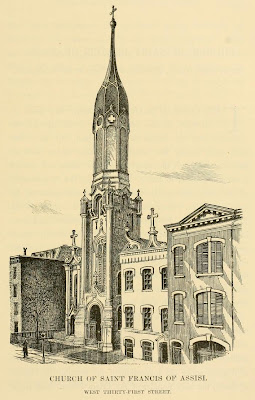Its history begins in early 1844, when Father Zachary Kunz, a Hungarian Franciscan, purchased a lot of land at 31st Street between 6th and 7th Avenues. The neighborhood, then known as Bloomingdale, was mainly German. That summer a cornerstone was laid, and as a parish history notes, “a modest but solid little church was erected.” The homily at the dedication Mass was delivered in German. A parochial school was soon established, and in 1866 German Franciscan nuns took charge of it.
One historian describes the parish’s early history as one of “struggle and poverty.” Soon English-speaking Catholics attended the church. Some of the first pastors were not Franciscans, but diocesan priests from Germany, and it wasn’t until the Civil War that the parish was officially deemed a Franciscan ministry. According to one history, it was under Father Andrew Pfeiffer that the church “became really Franciscan.”
Soon, however, this neighborhood would cease to be a neighborhood, but a business center for the growing metropolis. In 1878, a historian of the New York Archdiocese wrote:
It was well indeed in our great commercial city, where men are so carried away by the insane desire for wealth that they lose religion, honor, and honesty, to have proposed as a model one who, in an age when trade seemed to absorb all minds, renounced the wealth of his father, a merchant prince of his day, and all the flattering future before him, to become poor and humble for Christ’s sake.
In 1878, a historian wrote: “The congregation is not by any means a large one, nor does it number many on whom Providence has showered wealth.” But the present church building was erected in 1892, with four new bells (named Immaculate, St. Francis, St. Clare, and Angelus Domini.)
Ironically, by the turn of the century, as the number of parishioners declined, the “little church among the skyscrapers” expanded its ministries. In March 1904, Father Eusebius Schlingmann, the pastor, introduced what became known as the “Nightworkers’ Mass,” which was celebrated at 2 a.m. Three years later, St. Francis parish introduced a noon Mass (the first in America) for working people.
St. Francis became a pioneer in urban ministry. It introduced the the notion of the “service church” ministering to workers, shoppers and commuters.During the 1920’s, Father Anselm Kennedy instituted the practice of hearing confessions throughout the day. This practice still continues, and is one of the parish’s most significant ministries. During the 1930’s, regular visitors to the confessional included Thomas Merton and Dorothy Day.
In September 1930, at the start of the Great Depression, Brother Gabriel Mehler began the St. Francis Breadline to feed the urban poor. Eighty years later, it’s the oldest continually-running breadline in the country, daily feeding nearly three hundred people. Father Michael Carnevale, the breadline’s current director, says of this ministry: “It is our responsibility as Franciscans to respond to God’s poor and needy.”
In 1959, the New York Times referred to St. Francis as “one of the world’s busiest Roman Catholic churches.” This is truer than ever. Although the parish school closed years ago, adult education courses attract people citywide. Nine daily Masses are well attended, and the confessional always has a line. There are a variety of support groups, and a successful ministry to Asian Catholics. In the wake of 9/11, St. Francis was a rallying point for the nation as it celebrated the life and ministry of Father Mychal Judge.
The motto of the Franciscan order is Pax et Bonum, “peace and good.” Over eight hundred years ago, Francesco di Bernardone walked the streets of Assisi singing God’s praises and performing works of mercy. Today his friars provide a spiritual haven in a busy city where life and work can be overwhelming. In a place where it’s very easy to get caught up in the craziness of the day, they offer New Yorkers God’s peace and perform numerous works of good.












